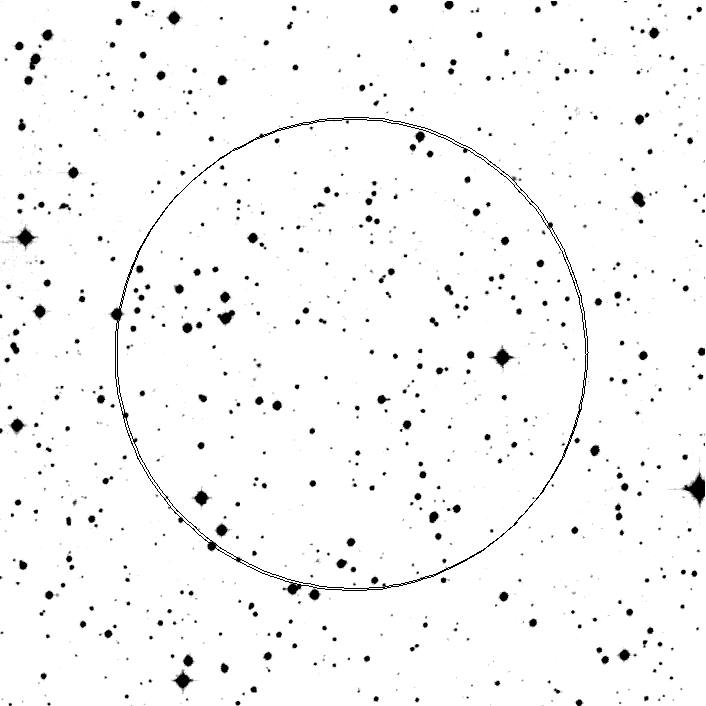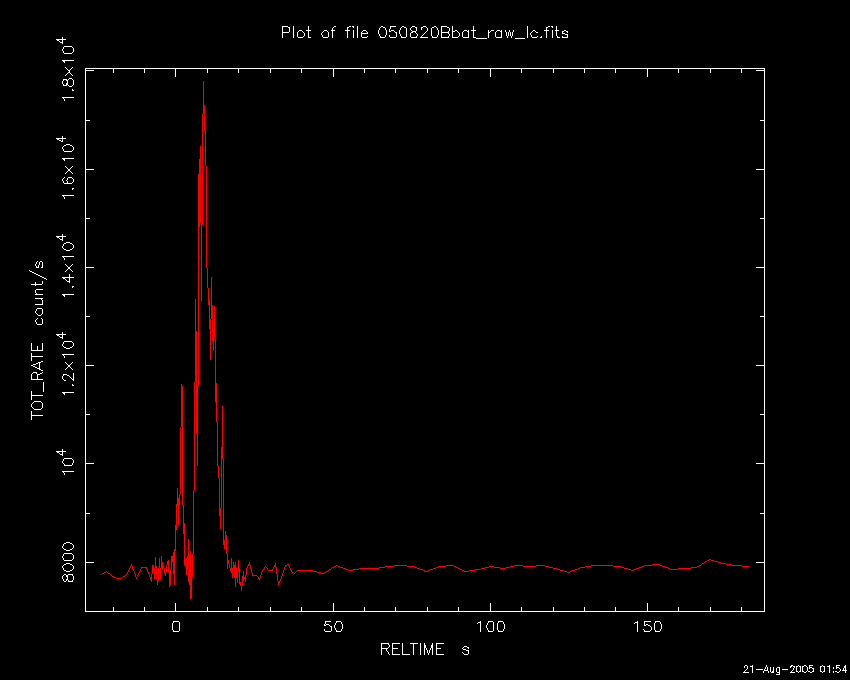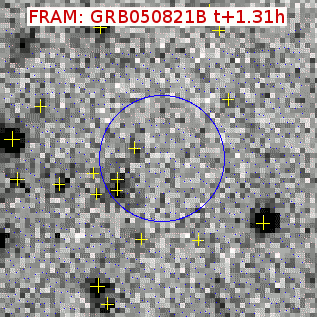- GCN/BACODINE POSITION NOTICE
TITLE: GCN/SWIFT NOTICE
NOTICE_DATE: Sat 20 Aug 05 23:50:48 UT
NOTICE_TYPE: Swift-BAT GRB Position
TRIGGER_NUM: 151334, Seg_Num: 0
GRB_RA: 135.557d {+09h 02m 14s} (J2000),
135.559d {+09h 02m 14s} (current),
135.537d {+09h 02m 09s} (1950)
GRB_DEC: -72.668d {-72d 40' 03"} (J2000),
-72.690d {-72d 41' 23"} (current),
-72.469d {-72d 28' 07"} (1950)
GRB_ERROR: 4.00 [arcmin radius, statistical only]
GRB_INTEN: 5634 [cnts] Image_Peak=265 [image_cnts]
TRIGGER_DUR: 1.024 [sec]
TRIGGER_INDEX: 137 E_range: 25-100 keV
BKG_INTEN: 35969 [cnts]
BKG_TIME: 85808.00 SOD {23:50:08.00} UT
BKG_DUR: 8 [sec]
GRB_DATE: 13602 TJD; 232 DOY; 05/08/20
GRB_TIME: 85827.19 SOD {23:50:27.19} UT
GRB_PHI: 170.96 [deg]
GRB_THETA: 20.19 [deg]
SOLN_STATUS: 0x3
RATE_SIGNIF: 14.28 [sigma]
IMAGE_SIGNIF: 8.76 [sigma]
MERIT_PARAMS: +1 +0 +0 +0 +2 +19 +0 +0 -8 +1
SUN_POSTN: 150.21d {+10h 00m 51s} +12.15d {+12d 09' 13"}
SUN_DIST: 85.39 [deg]
MOON_POSTN: 347.64d {+23h 10m 33s} -8.03d {-08d 01' 38"}
MOON_DIST: 96.68 [deg]
MOON_ILLUM: 98 [%]
GAL_COORDS: 287.74,-16.98 [deg] galactic lon,lat of the burst (or transient)
ECL_COORDS: 221.52,-73.50 [deg] ecliptic lon,lat of the burst (or transient)
COMMENTS: SWIFT-BAT GRB Coordinates.
COMMENTS: This is a rate trigger.
COMMENTS: A point_source was found.
COMMENTS: This does not match any source in the on-board catalog.
COMMENTS: This does not match any source in the ground catalog.
COMMENTS: This is a GRB.
- red DSS finding chart
ps-file

- GCN/SWIFT NOTICE
TITLE: GCN/SWIFT NOTICE
NOTICE_DATE: Sat 20 Aug 05 23:54:00 UT
NOTICE_TYPE: Swift-BAT GRB Lightcurve
TRIGGER_NUM: 151334, Seg_Num: 0
GRB_RA: 135.557d {+09h 02m 14s} (J2000),
135.559d {+09h 02m 14s} (current),
135.537d {+09h 02m 09s} (1950)
GRB_DEC: -72.668d {-72d 40' 03"} (J2000),
-72.690d {-72d 41' 23"} (current),
-72.469d {-72d 28' 07"} (1950)
GRB_DATE: 13602 TJD; 232 DOY; 05/08/20
GRB_TIME: 85827.19 SOD {23:50:27.19} UT
TRIGGER_INDEX: 137
GRB_PHI: 170.96 [deg]
GRB_THETA: 20.19 [deg]
DELTA_TIME: 32.00 [sec]
TRIGGER_DUR: 1.024 [sec]
LC_URL: sw00151334000msb.lc
SUN_POSTN: 150.21d {+10h 00m 51s} +12.15d {+12d 09' 13"}
SUN_DIST: 85.39 [deg]
MOON_POSTN: 347.64d {+23h 10m 33s} -8.03d {-08d 01' 38"}
MOON_DIST: 96.68 [deg]
MOON_ILLUM: 98 [%]
GAL_COORDS: 287.74,-16.98 [deg] galactic lon,lat of the pointing direction
ECL_COORDS: 221.52,-73.50 [deg] ecliptic lon,lat of the pointing direction
COMMENTS: SWIFT-BAT GRB Lightcurve.
COMMENTS:
COMMENTS: The next comments were copied from the BAT_POS Notice:
COMMENTS: This is a rate trigger.
COMMENTS: A point_source was found.
COMMENTS: This does not match any source in the on-board catalog.
COMMENTS: This does not match any source in the ground catalog.
COMMENTS: This is a GRB.

- GCN/SWIFT NOTICE
TITLE: GCN/SWIFT NOTICE
NOTICE_DATE: Sun 21 Aug 05 00:17:45 UT
NOTICE_TYPE: Swift-XRT Nack-Position
TRIGGER_NUM: 151334, Seg_Num: 0
POINT_RA: 135.557d {+09h 02m 14s} (J2000)
POINT_DEC: -72.670d {-72d 40' 11"} (J2000)
GRB_DATE: 13603 TJD; 233 DOY; 05/08/21
GRB_TIME: 1057.22 SOD {00:17:37.22} UT
COUNTS: 22 Min_needed= 20
STD_DEV: 45.00 Max_StdDev_for_Good=28.44 [arcsec]
PH2_ITER: 3 Max_iter_allowed= 4
ERROR_CODE: 3
COMMENTS: SWIFT-XRT Nack Position.
COMMENTS: Standard deviation too large.
- GCN notice #3839
M. Page (UCL-MSSL), D. Palmer (LANL), S. Barthelmy (GSFC),
D. Burrows (PSU), A. Beardmore (U. Leicester). J. Kennea (PSU),
M. Chester (PSU), and T. Sakamoto (GSFC/NRC)
on behalf of the Swift team report
At 23:50:27 BAT triggered and located GRB050820B (Trigger= 151334)
at RA,Dec=135.557d, -72.668d {+09h 02m 14s, -72d 40' 03"} (J2000)
with an uncertainty of 2 arcmin (radius, 90% containment, stat+sys).
The BAT lightcurve shows 20 seconds of emission with a shorter
softer peak at T+2 seconds, and a broader, brighter, harder
interval of emission from T+6 to T+14s. The peak count rate
is 10,000 counts/s (15-350 keV) at T+9s. The first peak has
a maximum count rate of 2000 counts/s, with no obvious
emission above 100 keV.
Due to Earth limb constraints, the Swift slew is delayed until
until 00:16 UT (T+26 minutes).
- GCN notice #3840
E. Fenimore (LANL), L. Barbier (GSFC), S. Barthelmy (GSFC),
J. Cummings (GSFC/NRC), N. Gehrels (GSFC), D. Hullinger (GSFC/UMD),
K. Hurley (Berkeley), H. Krimm (GSFC/USRA), C. Markwardt (GSFC/UMD),
J. Norris (GSFC), D. Palmer (LANL), A. Parsons (GSFC),
T. Sakamoto (GSFC/NRC), G. Sato (ISAS), J. Tueller (GSFC)
on behalf of the Swift-BAT team:
Using the full data set from the recent telemetry downlink, we report
further analysis of Swift-BAT GRB 050820B (trigger #151334)
(Page, et al., GCN 3839). The ground-analysis position is
RA,Dec 135.594,-72.639 (J2000) with an uncertainty of 2 arcmin
(radius, 90%, stat+sys).
The light curve show a peak at T+1 sec and a cluster of merged
peaks at T+8 sec. T90 is 13 +/-2 sec.
Fitting a cutoff power law over the interval from T+0.2 to T+17.3 sec,
the photon index is 0.5 +/- 0.2 and Epeak is 100 (-10/+15) keV
with a fluence of 2.8 +/- 0.2 x 10^-6 erg/cm^2 in the 15-350 keV
band (90% c.l.). The peak flux in a 1-sec wide window starting at
T+8.7 seconds is 4.7 +/- 0.3 ph/cm^2/sec (15-350 keV).
- GCN notice #3841
N. Schartel (XMM-Newton/ESA) reports:
XMM-Newton will observe GRB050820B at location
(RA=09h 02m 22.6s, DEC=-72d 38' 20.4", J2000),
starting at 05:03 UT, on August 21, 2005,
for an exposure of 59ksec seconds.
- GCN notice #3842
D. N. Burrows (PSU) reports on behalf of the Swift XRT team:
The Swift BAT instrument triggered on GRB 050820B at 23:50:27.19 UT (GCN
3839, Page et al.). At that time, the source was within the Earth limb
constraint and the S/C was not able to slew immediately. Swift executed a
delayed slew at 0:17:37, while the observatory was in the South Atlantic
Anomaly. The XRT attempted to locate a bright source in its field of view,
but was not able to do so due to the delayed slew and to the presence of
many charged particle events in the image. XRT Photon-Counting mode
observations began at 00:28:3.6 (2256 s after the burst trigger), following
exit from the South Atlantic Anomaly and completion of pre-programmed XRT
engineering data collection. In analysis of engineering format (PASS1)
ground-processed data at the MOC, we find a faint, fading, uncataloged
X-ray source located at:
RA(J2000) = 09h 02m 24.6s
Dec(J2000) = -72d 38' 43"
with an estimated uncertainty of 8 arcseconds (90% containment
radius). This position is 25 arcseconds from the refined BAT position
reported in GCN 3840 (Fenimore et al.).
Further observations are in progress. Refined analysis will become
available following processing of the data through the Swift Data Center's
pipeline.
- GCN notice #3844
Pedro Rodriguez and Pedro Calderon report:
Quick-Look-Analysis of the XMM-Newton observation of the GRB050820B
field based on an exposure in the EPIC pn camera that started at 05:50 UT,
shows the
presence of a source within the SWIFT/XRT error circle (Burrows, GCN3842).
The estimated EPIC/pn net count rate for the first 1ksec is 0.033 counts/sec.
- GCN notice #3851
M. Chester (PSU), M. Page (UCL-MSSL), F. Marshall (GSFC), P. Roming (PSU),
D. Hinshaw (GSFC-SPSYS), P. Meszaros (PSU), N. Gehrels (GSFC)
on behalf of the Swift UVOT team.
Swift/UVOT observed GRB 050820B in its UV filters only, due to the
presence of a
V=4.5 star in its field of view. The afterglow was not detected at the
XRT position.
5-sigma upper limits are:
Filter Magnitude Exp (s) T_start T_stop
UVM2 >19.1 100 1987 2087
UVW1 >19.0 100 2091 2191
UVW2 >19.3 100 2198 2298
where T_start and T_stop are in seconds after the trigger (Page et al.
GCN 3839).
- GCN notice #3854
Martin Jel=EDnek (IAA Granada, Spain),
Michael Prouza (FZU Praha, Czech Republic),
Petr Kubanek (ISDC Versiox, Switzerland and ASU AV CR, Ondrejov),
Martin Nekola and Rene Hudec (ASU AV CR, Ondrejov, Czech Republic)
report:
Robotic telescope FRAM located near Malargue in Argentina has
observed the field of GRB050820B in semi-automatic mode
starting 1.31h after the GRB onset. No new optical source is
detected within the uncertainity region given by GCN3840
(Fenimore et. al.). The 3-sigma limit of three coadded
exposures is R=3D15.3. An image can be seen at
http://lascaux.asu.cas.cz/~mates/050820B-fram.gif

- GCN notice #4005
Andrea De Luca (IASF Mi) on behalf of a larger collaboraton
report:
We have analyzed the data from the XMM-Newton observation
of GRB050820B, discovered by Swift (Page et al., GCN3839)
on 2005, August 20 at 23:50:27 UT.
The XMM-Newton observation started on 2005, August 21 at
05:21:30 UT (~5h 30min after the GRB) and lasted for 58.5 ks.
We report here on the analysis of the data collected by
the EPIC instrument.
As reported by Rodriguez & Calderon (GCN3844),
the afterglow of GRB050820B is detected in all the EPIC cameras.
The background-subtracted, time-averaged count rate in the pn camera,
estimated from a 25" radius extraction region (containing ~80%
of the total counts), is 0.014+/-0.001 cts/s in the 0.2-8 keV
energy range.
We improved the astrometry of the XMM-Newton/EPIC images
by matching X-ray sources in the field to stars in the USNO-B1
catalogue. The refined position (J2000) for the X-ray afterglow is
RA: 09h 02m 25.03s Dec: -72d 38' 44.0"
The 1 sigma error radius is 1.5 arcsec (including the rms error on
the cross-correlation as well as systematic uncertainties in the
optical catalogue). The position is consistent with the XRT
coordinates reported by Burrows (GCN3842).
The afterglow is clearly seen to fade along the XMM-Newton
observation, spanning the time range 20-79 ks after
the GRB. The background-subtracted light curve (0.3-3 keV)
decays as a power law with index delta=1.55+/-0.15 (90% c.l.)
(reduced chi2=1.3, 28 d.o.f.).
We extracted time-averaged spectra from the three EPIC cameras
and we generated ad-hoc response files.
We quote here errors at 90% confidence level for a single interesting
parameter.
A simultaneous fit with an absorbed power law model yields a good
description of the data (reduced chi2=0.90, 67 d.o.f.). The best fit value
for the NH is 1.6+/-0.4x10^21 cm^-2, somewhat higher than the expected
Galactic value in the burst direction (NH~8x10^20 cm^-2, Dickey & Lockman,
1990); the best fitting power law photon index is Gamma=2.3+/-0.2.
The observed flux in the 0.2-10 keV range is 4.1x10^-14 erg cm^-2 s^-1,
corresponding to an unabsorbed flux of 7.7x10^-14 erg cm^-2 s^-1.
No significant spectral variation as a function of the time is
found in the data.
![]() Previous IAU Circulars
Previous IAU Circulars 

